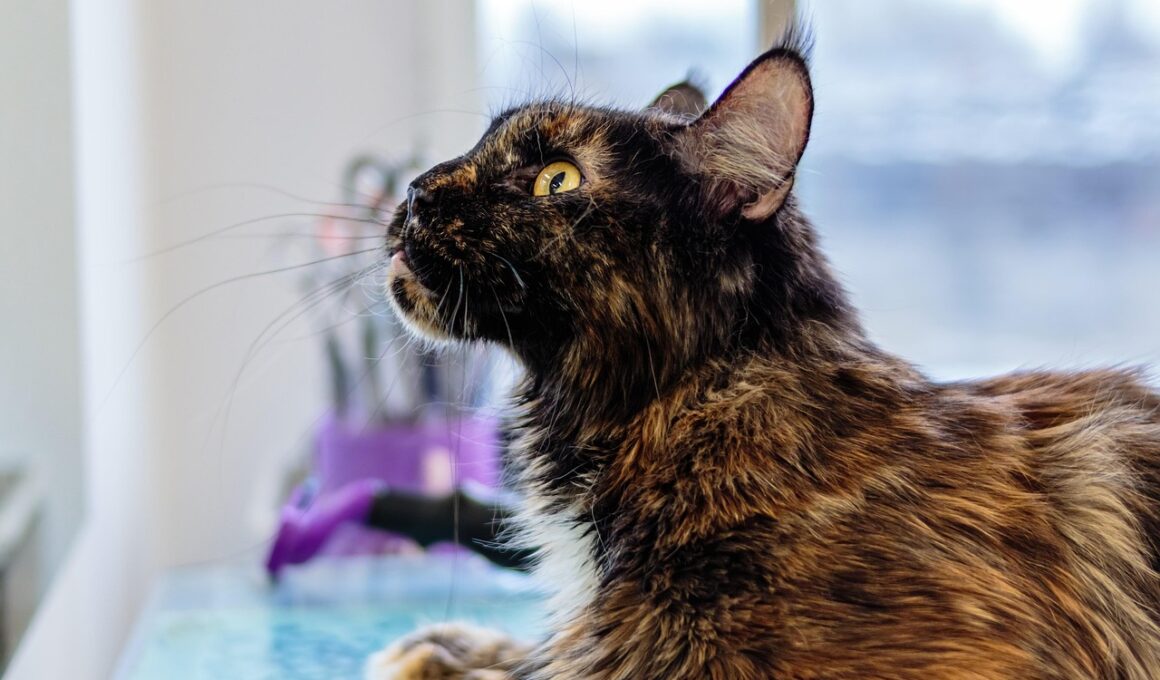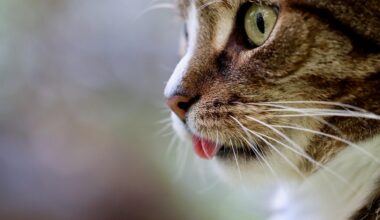Seasonal Cat Grooming Tips for Pet Owners
As every seasoned pet owner knows, cat grooming requires a thoughtful approach, especially during seasonal changes. The first step is to consider the type of coat your feline has, whether it’s long or short-haired. Seasonal shedding can vary significantly; thus, it’s vital to adapt your grooming method accordingly. Regular brushing helps manage loose fur, reducing the chances of hairballs in your home. Start grooming your cat at least twice a week during peak shedding seasons like spring and fall. When you’re brushing, make sure to use a gentle touch and look for mats or tangles, which can irritate the cat’s skin. Temporary changes in humidity can also influence your cat’s coat; therefore, be aware of how dry or humid it is outside. You can use a humidifier to help maintain an optimal environment for both you and your pet. Beyond a proper brushing routine, consider keeping your cat’s claws trimmed and ears clean to maintain overall health. Providing treats can positively reinforce grooming habits as a pleasant shared experience for both you and your feline friend.
As the seasons shift, it becomes even more important to pay attention to your cat’s grooming needs. During winter, indoor heating can lead to dry skin, making it crucial to incorporate a moisturizing shampoo in your grooming strategy. Look for products specifically formulated for cats that contain natural oils to keep their coat hydrated. Additionally, offering a nutrient-rich diet can improve skin health. Fish oil, for example, is beneficial and can create a shiny coat. Always consult with your veterinarian for proper dosage instructions. Also, ensure your cat has access to fresh water at all times. Dehydration can exacerbate skin issues, so it’s essential to encourage drinking. Supplementing with fish-flavored water might encourage some finicky felines to drink more. Regularly check their paws, as the cold can crack pads easily, so consider using pet-safe creams to protect them. Beyond skin care, seasonal allergies might occur, leading cats to scratch. Hence, pay attention to any potential irritants in your home that could be causing discomfort. A thorough understanding of your cat’s specific grooming needs enhances their comfort and enjoyment through all seasons.
Summer Grooming Essentials
In summer, your cat’s grooming routine should focus on keeping them cool. High temperatures can lead to overheating, especially in cats with thicker coats. Regular brushing will help remove dead hair and allow for better air circulation, preventing matting which can trap heat. Consider investing in a suitable grooming tool for your cat’s specific coat type. A de-shedding tool might be ideal during the hot months. It’s also important to monitor your cat for signs of heat stress, such as excessive panting or lethargy. In addition to grooming, bathing your cat occasionally can help refresh them without losing essential oils. Choose a mild, cat-safe shampoo. Ensure to rinse thoroughly to prevent skin irritation. Post-bath, drying your cat gently with a towel and setting them in a cool area can ease the process. Keep in mind, however, that not all cats enjoy water. Start slowly to build their comfort while grooming. If you are unsure about bathing your cat, consult your veterinarian for advice on alternatives to maintain hygiene during the summer heat.
During summer months, your cat is also prone to parasites such as fleas and ticks. Regular brushing serves as the first line of defense against these pests, as it allows you to spot them early. Consider using a topical flea treatment when necessary, but talk with your veterinarian to find the right product. Also, keep your home environment clean by vacuuming frequently and using pet-safe pest repellents. Sun protection is another aspect some cat owners overlook during hot months. If your cat spends time outdoors, particularly if they have light skin or fur, consider using pet-safe sunscreen on vulnerable areas like the nose and ears. Shade is important, so ensure there’s plenty of it in your yard. Hydration is still essential, so always have fresh water available. Additionally, consider elevating your cat’s food and water bowls, making them accessible to your cat when they are too hot. Adapting your grooming habits during summer doesn’t only enhance your cat’s comfort; it can also positively impact their overall health when paying attention to early warning signs.
Fall Grooming Practices
As leaves begin to change and cooler breezes return, your cat’s grooming routine should also adjust. During fall, the shedding will likely increase as cats prepare for their winter coats. Frequent brushing is essential, potentially up to three times a week, to minimize matting and fur build-up in your home. Transition to the appropriate grooming tools, such as a slicker brush, to handle any tangles that may develop. Meanwhile, pay close attention to your cat’s skin and coat health; nutritional supplements like omega fatty acids can support a healthy coat. Always remember to check for lumps or strange growths which could be intensified with changing temperatures. It’s also advisable to schedule a fall vet check-up, especially if your cat appears to be scratching more than usual. Adapt their living space to ensure warmth is readily available either from sunlight or heated beds. Consider changing to a heavier blanket in their favorite resting places before the cold sets in. Ensuring that your cat remains cozy can significantly enhance their comfort level as the weather changes significantly during this time.
Additionally, fall brings about potential allergies as different plants become prevalent and airborne pollen shifts. Watch for any signs of discomfort such as sneezing, excessive scratching, or watery eyes. These symptoms might indicate seasonal allergies, requiring a vet visit for proper care options. Along with adapting to grooming needs, pay attention to how your home environment might change due to the season. Ensure that your cat has consistent access to fresh water and is not neglected in its grooming responsibilities. Creating a pleasant grooming atmosphere can strengthen your bond during these rituals. Introduce this through gentle handling techniques or playtime before and after grooming sessions. Always be patient; some cats can be quite sensitive during transitions. Use calming treats or pheromone diffusers to ease their stress. As autumn progresses, be alert to the decline in daylight hours. Adjusting the ambiance within your home can positively affect your cat’s mood. Their coat may need extra attention due to thermal regulation changes, showing how essential seasonal care truly is.
Winter Grooming Guidelines
With the arrival of winter, grooming takes on an entirely new aspect, primarily focused on maintaining warmth and comfort. Indoor heating affects the feline coat, causing dryness and the potential for flaky skin. It’s important to maintain a consistent brushing routine at this time. Brushing helps to distribute natural oils and prevents mats, especially in long-haired breeds. Bathing may also be necessary but be cautious not to strip the coat of its natural oils. Use a moisturizing cat shampoo to prevent further dryness. Keeping your home humidified can greatly assist in maintaining optimal fur condition, so invest in a good home humidifier. Litterbox hygiene is likewise paramount in winter, as cats may spend more time indoors. Ensure that their litter area is clean, allowing them to feel comfortable. If your cat begins to spend less time grooming their coat, consider brushing them more often. Regular grooming is an excellent way to bond while simultaneously enhancing your cat’s physical appearance during the colder season ahead. Understanding seasonal grooming variations, it ensures that your cat stays comfortable, which helps maintain their overall happiness.
When introducing winter grooming, observe any changes to your cat’s energy levels or behavior. Seasonal affective disorder may even impact cats, as fewer daylight hours might cause lethargy. Engage in play sessions and maintain stimulation with assorted toys. Indoor activities are also crucial during this time to keep your furry friend entertained. As a precaution, inspect both the fur and skin for any signs of grooming issues, as dry skin can lead to more severe dermatological problems. Always consider consulting a veterinarian if you happen to see persistent scratching or bald spots. Pay attention to their paws; snow and ice can lead to chilly pads and potential injuries. Protect those delicate paw pads by using booties if your cat is inclined to venture outside. Even if your cat does not enjoy these garments, they provide necessary warmth on frosty surfaces. During winter, ensuring your cat receives adequate grooming supports their comfort and health effectively. Through attentive care, you build trust and reinforce positive associations, making the grooming process more enjoyable for both you and your beloved animal companion.


